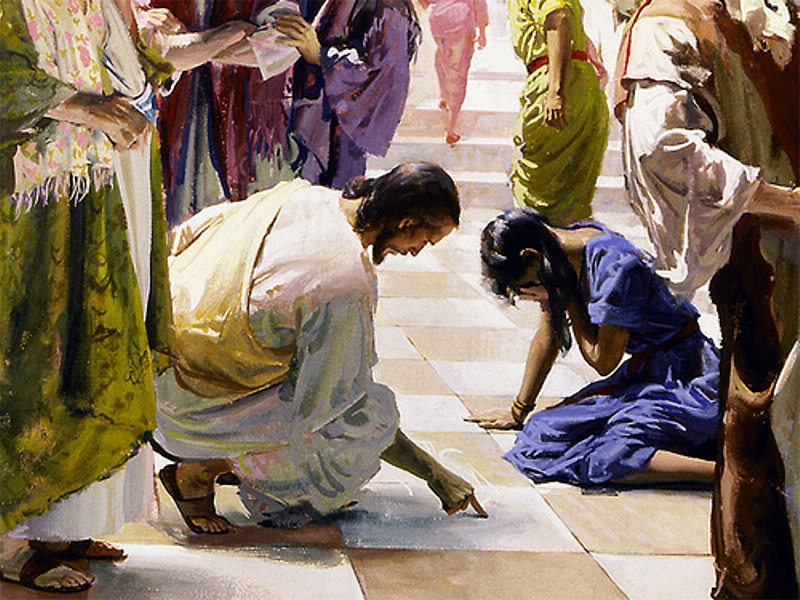JC & the Law: forgiving the adulteress … (12/14/18)
The beginning verses of John 8 relay our next episode of import; the infamous moment when Jesus firmly (and quite cleverly) rebukes a group of ill-intended Pharisees for wrongfully condemning an accused adulteress.1 In this tale, while Jesus was teaching in the Temple2, several members of “the scribes and the Pharisees” bring a woman before him who had supposedly been caught in the act of adultery; brazenly stating: “In the Law Moses commanded us to stone such women. What do you say to this?” Now, as the text openly admits, “they said this to test him, so that they might have a charge to bring against him” (John 8:6a), and this was indeed the case – seeing as how Jesus was trapped; on the one hand the Jewish Law clearly mandated the death penalty for such a transgression (via Deuteronomy 22:22 & Leviticus 20:10), while on the other hand the Roman law was clear that Jews did not have the authority to execute criminal law-breakers (see John 18:31). In essence, the Pharisees had set it up where Jesus could either openly repudiate the woman’s punishment and thereby publicly denounce the Law of Moses, or affirm her death sentence and thereby publicly subvert (and incur the wrath of) the Roman authorities (not to mention openly violate the principles of humble compassion and unconditional forgiveness at the very heart of his own ministry). Of course, it was obvious to everyone in attendance that those who had brought the woman to Jesus had no interest in seeing true justice upheld. After all, if that form of “justice” had been truly desired, they would have brought the woman before the Sanhedrin inside the Temple walls to be judged therein, not before a half-accepted prophet (and oft-denounced “heretic”) teaching just outside the same. As such, Jesus’ response was as appropriate as it was brilliant – exposing the immoral hypocrisy at the core of their claim (“Let the one among you who is without sin throw the first stone” ~ John 8:7)3 while simultaneously proving that his understanding of the Law was far greater than their own; doing so by calmly writing on the ground in silence4 until they all departed and left the woman in peace, ostensibly “to violate the Law no more.” (John 8:11)

…………………………………………………….
1A significant portion of modern scholars consider this passage (John 8:1-11) to be fully legitimate, despite the fact that none of the earliest manuscripts of John‘s Gospel contain its wording in any form. This is possibly due to its mention and acceptance by many early biblical historians and Christian theologians (including Jerome, St. Augustine, and Leo the Great), as well as the fact that its meter and underlying principles resonate harmoniously with the rest of Jesus’ ministry as recorded in the Gospels.
2Due to the holiness of the Temple (and the strict regulations concerning those who were allowed to enter it) and the apparently large crowd of people who had come to hear him, it is actually more likely that Jesus was teaching just outside the Temple or directly in front of it – neither of which in any way diminishes the potency of this particular commentary.
3Doing so both generally via Matthew 7:1-2‘s “Do not judge, so that you may not be judged. For with the judgment you make you will be judged, and the measure you give will be the measure you receive”, as well as specifically via the text of Deuteronomy 22:22 & Leviticus 20:10 – both of which mandated quite clearly that not only the woman caught in said act be stoned to death, but her male counterpart as well. Indeed, the Pharisees in this story had admitted straight away in John 8:4 that they had personally witnessed the crime – that the woman had been caught “in the very act”, and yet as Jesus then pointed out in John 8:7 (referencing the law set out in Deuteronomy 17:7 which required the witness of any capital offense to throw the first stone), if this was indeed the case then they must also know the identity of the male violator as well – the man who they had refused to bring forth. How can they condemn the one without the other?
4The possible content of Jesus’ writings in the dust here remain open for debate. Maybe he was listing the specific sins of each accuser present, leading them to depart one by one in self-reflective shame (“Why do you notice the speck in your neighbor’s eye, but do not recognize the log in your own?” ~ Matthew 7:3), and maybe he was simply writing general legal platitudes from the scriptures. Either way, what is missed here is the far deeper statement being made – the statement that Jesus did indeed understand the intricacies of the Law far more profoundly than his opponents; that he was even aware of the Oral Law – just as binding – that prohibited the writing of even two letters on the Sabbath (Mishnah Sabbat 7:2) while exempting any Sabbath script written “with fruit juice, or in the dust of the road” (Mishnah Sabbat 12:5) … In this way he simultaneously upheld the Law and his dramatically Mercy-ladled reform thereof.




 ;
;